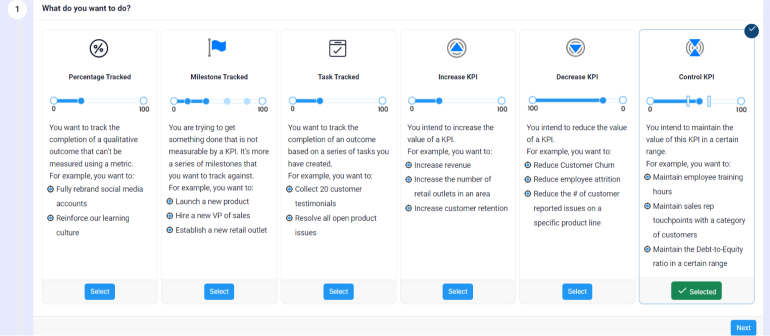An important aspect of achieving a goal is consistent commitment. A common key result for important objectives is hitting a recurring target. For example, a sales representative might have an objective to “Have an outstanding quarter with new clients”. One key result that will help the sales representative achieve that goal is to require that they make 100 calls per week for the 13 weeks of the quarter.
How do we track this key result? While the first thing that comes to mind is to use an Increase KPI key result, in reality, the best way to track a goal like this is to use Control KPI.
Let’s look at another example: If a manager needs to send out a weekly report, every week, for all 13 weeks of the quarter, they can use a control KPI and structure their key result as follows:

After selecting Control KPI, the manager can choose “Weekly Reporting” as the KPI. This will be tracked numerically, on a scale of 0 to 1.

The key result will be maintained at “at least” 1 and checked in weekly. Here, ‘1’ indicates that the weekly report was sent out, while ‘0’ indicates that it was not. So, each week, the manager will either check-in with a yes: 1 or a no: 0.

So, the OKR could look something like this:

The first week of the quarter, the manager would complete the check-in and indicate that they sent out the weekly report.

This will move the key result progress bar by 8%, and the overall OKR progress by 8%, if there are other key results created below the same objective, then the overall percentage of the OKR will be progressed based on the progress of all the keyresults towards the objective. The next week, the manager again sends out the weekly report, so they check in the key result as “1”. The key result progress will move an additional 7-8%, depending on the number of weeks left in the quarter, and the Objective progress to another 4%, because they have maintained the desired standard for one more week.

If the manager does not send out the weekly report, the key result would be instead checked-in as ‘0’. This will retain all previous progress but does not change the progress bar of that key result because the manager did not maintain the necessary lower limit.

By using a control KPI, a manager can continually track the completion of weekly targets without having to wait until the end of the quarter to log progress, and using an Increase KPI can be misleading and unnecessarily complicated.
The key result progress bar will give an accurate percentage of the completion of this key result at the end of the quarter, making this tracking method more effective and useful than using an Increase KPI key result.
Final Thoughts:
You can align and adjust activities that are meant to occur every week, and choosing control KPI sets the momentum for progress and encourages you to stick to the weekly/recurring target. It is mandatory to keep the weekly/recurring target perfect, but it has to be smart enough to achieve it at regular intervals with the help of the right platform. Profit.co helps you to organize your weekly goals in a realistic way. Tracking key results using Control KPI can help you set Upper and lower limits, thereby letting you keep your focus on limits, and achieve them on time.
